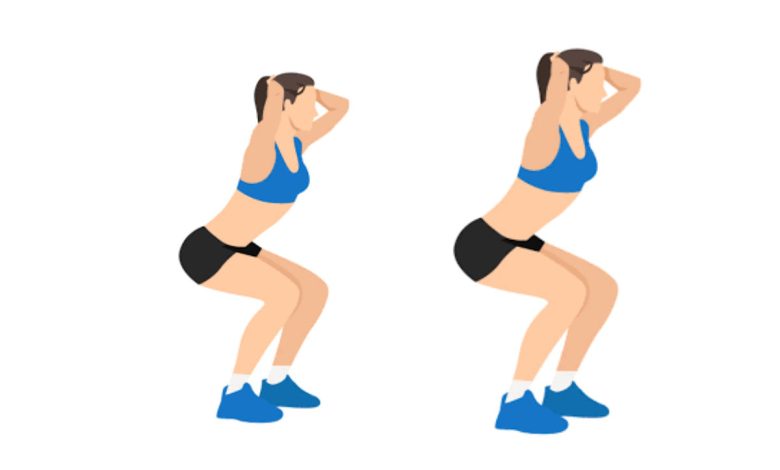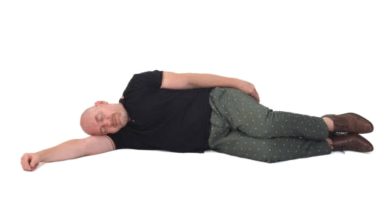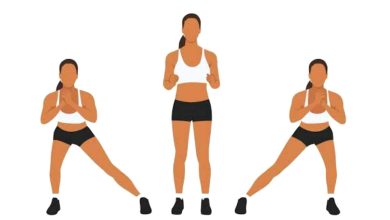Prisoner Squat Exercise: Rules, Benefits, and Tips
The Prisoner Squat: A Comprehensive Guide to Powerful Exercise

The Prisoner Squat is a simple yet highly effective bodyweight exercise that offers a wide range of benefits for people of all fitness levels. As part of the larger family of squat variations, the Prisoner Squat targets the lower body, core, and even posture, making it a versatile movement that requires no equipment and can be done virtually anywhere. This article delves into the mechanics, benefits, variations, common mistakes, and how to incorporate Prisoner Squats into your workout routine, providing a comprehensive guide for those looking to build strength, endurance, and mobility.
What Is the Prisoner Squat exercise?
The Prisoner Squat is a type of bodyweight squat that gets its name from the position of the arms during the movement. Unlike traditional squats where arms are placed forward or on the hips, in a Prisoner Squat, the hands are placed behind the head, with elbows pointing out to the sides. This arm positioning increases the engagement of the upper back, challenges core stability, and encourages good posture throughout the movement. The exercise primarily works the quadriceps, hamstrings, glutes, and core, but also involves the shoulders and upper back to maintain proper form.
How to Perform a Prisoner Squat exercise Correctly
The key to maximizing the benefits of any exercise is correct form. Here’s a step-by-step guide to performing a Prisoner Squat:
1.Starting Position
- Stand with your feet shoulder-width apart.
- Place your hands behind your head, interlacing your fingers lightly or resting them comfortably.
- Ensure that your elbows are pointing out to the sides, keeping your chest open and your shoulder blades slightly squeezed together.
- Engage your core muscles and keep your back straight.
2.Initiating the Squat
- Begin the movement by pushing your hips back as if you’re sitting in an imaginary chair.
- Bend your knees and lower your body, keeping your weight on your heels.
- Your knees should track over your toes without collapsing inward.
3.Lowering Down
- Continue to lower your body until your thighs are at least parallel to the ground, or as deep as your mobility allows. Some people may be able to squat deeper, which is fine as long as they can maintain proper form.
- Throughout the movement, keep your chest upright, core braced, and back straight to avoid rounding the lower back.
4.Returning to Standing
- Push through your heels to extend your legs and return to the starting position.
- As you rise, make sure to engage your glutes and maintain core tension.
- Keep your chest lifted and avoid leaning forward.
5.Repetitions
- Repeat for the desired number of repetitions, usually between 10-20 for general fitness or more for endurance and conditioning.
Key Benefits of the Prisoner Squat exercise
1.Improved Posture
One of the standout benefits of the Prisoner Squat is its emphasis on posture. With your hands behind your head and elbows out, the exercise naturally opens the chest and encourages a neutral spine. This positioning strengthens the muscles of the upper back, helping to counteract the rounded shoulders and forward head posture that many people develop from sitting at desks or hunching over screens.
2.Full-Body Engagement
While the primary focus of the Prisoner Squat is the lower body—particularly the quadriceps, hamstrings, and glutes—it also involves the upper body and core. Keeping your hands behind your head activates the muscles in your upper back and shoulders, while your core must work harder to maintain stability and balance throughout the movement.
3.Increased Core Activation
In traditional squats, the core is engaged to support the spine, but the positioning in the Prisoner Squat increases this demand. With the hands behind the head, the body has to work harder to maintain stability, particularly in the abdominal and lower back muscles, providing an added core workout without any additional equipment.
4.Lower Body Strength and Endurance
Like all squat variations, the Prisoner Squat is excellent for building strength and endurance in the lower body. The movement targets the quadriceps, hamstrings, glutes, and calves, making it a highly effective exercise for improving both muscle tone and functional strength.
5.Improved Mobility
The deep squat position required in a Prisoner Squat helps improve mobility in the hips, knees, and ankles. Over time, this can lead to better movement patterns, reduced risk of injury, and increased performance in both athletic and everyday activities.
6.No Equipment Needed
One of the most significant advantages of the Prisoner Squat is that it can be done anywhere and requires no equipment. Whether you’re traveling, stuck at home, or simply don’t have access to a gym, this exercise offers a convenient way to maintain your fitness.
7.Enhanced Mental Focus
The Prisoner Squat forces you to concentrate on maintaining good form, particularly in keeping your chest open, back straight, and core engaged. This can help develop better body awareness and control, improving your overall fitness experience.
Common Mistakes to Avoid
Even though the Prisoner Squat is a straightforward exercise, improper form can diminish its effectiveness and increase the risk of injury. Here are some common mistakes to watch out for:
1.Rounding the Back
One of the most frequent errors is allowing the back to round, especially as you lower into the squat. This can place unnecessary strain on the lower back and lead to poor posture. To avoid this, keep your chest up, shoulders back, and engage your core throughout the movement.
2.Knees Caving Inward
Another common issue is letting the knees collapse inward as you squat. This not only reduces the effectiveness of the exercise but also puts added stress on the knee joints. Ensure that your knees track in line with your toes, pressing outward slightly as you descend.
3.Lifting the Heels
Many people tend to lift their heels off the ground during the squat, especially if they have tight calves or limited ankle mobility. This shifts the weight onto the toes, which can reduce stability and lead to improper mechanics. Focus on keeping your heels planted and your weight centered over your midfoot and heels.
4.Not Squatting Deep Enough
Some individuals perform shallow squats, stopping well before their thighs are parallel to the floor. While partial squats can still be beneficial, you’ll get more out of the exercise by lowering as far as your mobility allows. Aim for at least a 90-degree angle at the knees, or deeper if possible without compromising form.
5.Overextending the Neck
It’s easy to tilt your head up or down during the squat, but this can strain your neck and throw off your alignment. Keep your gaze forward, with your chin tucked slightly, and avoid looking too far up or down.
Variations of the Prisoner Squat
Once you’ve mastered the basic Prisoner Squat, you can add variety to your workout by incorporating some variations. These progressions can increase the difficulty, add a cardiovascular element, or target different muscle groups.
1.Prisoner Jump Squat
To turn the Prisoner Squat into a more explosive exercise, add a jump at the top of the movement. Perform a regular Prisoner Squat, and as you push back up, explode off the ground, jumping as high as you can. This variation is excellent for building power and increasing heart rate.
2.Prisoner Split Squat
In this variation, you’ll perform a split squat (a stationary lunge) with your hands behind your head. Start in a staggered stance with one foot forward and the other behind. Lower your hips until both knees are at 90 degrees, then push back up to the starting position. This exercise emphasizes single-leg strength and stability.
3.Prisoner Pulse Squat
If you want to increase the time under tension and really feel the burn, try adding pulses to your squats. Lower into the squat position and instead of standing back up, pulse up and down in the bottom half of the movement for a set number of repetitions before returning to standing.
4.Prisoner Squat with Resistance Band
To add some external resistance to your Prisoner Squat, use a resistance band around your thighs. This creates additional tension on your glutes and abductors as you perform the movement, helping to improve hip stability and strength.
5.Prisoner Squat to Side Leg Lift
For an added balance challenge and to engage the outer hips and thighs, incorporate a side leg lift at the top of each squat. Perform a regular Prisoner Squat, and as you return to standing, lift one leg out to the side, keeping your core engaged. Alternate sides with each repetition.
How to Incorporate Prisoner Squats into Your Routine
The Prisoner Squat can be used in various ways depending on your fitness goals. Here are a few ideas on how to integrate this exercise into your training:
1.As Part of a Warm-Up
Prisoner Squats are an excellent way to activate the lower body, core, and upper back before a workout. Perform 2-3 sets of 10-15 reps as part of your dynamic warm-up to get your body ready for more intense exercises.
2.In Bodyweight Circuits
Since the Prisoner Squat requires no equipment, it fits perfectly into bodyweight circuits. Combine it with exercises like push-ups, lunges, and planks for a full-body workout that can be done anywhere. For example, try this simple circuit:
- 15 Prisoner Squats
- 10 Push-ups
- 15 Reverse Lunges (each leg)
- 30-second Plank
Repeat for 3-4 rounds with minimal rest between exercises to build endurance and strength.
3.As a Strength Endurance Exercise
If you’re looking to improve muscle endurance, perform higher repetitions of the Prisoner Squat in your workouts. Aim for 3-4 sets of 20-30 reps, maintaining proper form throughout. This will not only help you build stamina in the lower body but will also test your mental resilience as the muscles fatigue.
4.In Plyometric or HIIT Workouts
The explosive Prisoner Jump Squat can be incorporated into high-intensity interval training (HIIT) routines to boost cardiovascular fitness while also building strength. For example, you can perform 30 seconds of Prisoner Jump Squats, followed by 30 seconds of rest, and repeat for several rounds. The jump variation adds intensity, making it perfect for short, intense bursts of activity.
5.As a Mobility and Flexibility Drill
Prisoner Squats can be used as a tool to improve lower body mobility. Performing the exercise slowly and with control allows you to deepen the squat and work on hip, knee, and ankle flexibility. Focus on maintaining a straight spine and open chest while lowering your body as deeply as possible. For a mobility-focused workout, combine Prisoner Squats with hip openers and stretches like the deep lunge stretch or pigeon pose.
Who Should Do Prisoner Squats?
Prisoner Squats are suitable for a wide range of people, from beginners to advanced athletes, and offer numerous benefits depending on your fitness level and goals.
1.Beginners
For those new to fitness, the Prisoner Squat is a great starting exercise. Since it requires no equipment and focuses on bodyweight resistance, it’s easy to perform at home and can help develop strength and mobility in the lower body without putting excessive strain on the joints.
2.Athletes
Athletes can use the Prisoner Squat as part of their strength and conditioning programs. The movement helps develop lower body power, endurance, and flexibility—all critical elements for athletic performance. Additionally, variations like the Prisoner Jump Squat or Split Squat can enhance explosive strength and single-leg stability, essential for sports that involve running, jumping, and quick directional changes.
3.People with Postural Issues
The unique arm position of the Prisoner Squat encourages better posture by engaging the muscles of the upper back and shoulders. People who spend a lot of time sitting at desks or who have postural imbalances from poor habits can benefit from including this exercise in their routine to help correct and strengthen the muscles responsible for good alignment.
4.Older Adults
Prisoner Squats are a safe, functional movement for older adults looking to maintain or improve lower body strength and balance. Since squatting is a fundamental movement pattern used in daily activities like sitting, standing, and picking things up from the floor, keeping these muscles strong is crucial for preserving independence as we age. For those with limited mobility, starting with a partial range of motion and gradually increasing squat depth is a great way to progress.
Programming Prisoner Squats for Specific Goals
1.For Strength and Muscle Building
If your goal is to build strength and muscle, you can use Prisoner Squats as part of a larger bodyweight or resistance training program. While the movement itself doesn’t provide heavy resistance like a weighted squat, it can still build muscle endurance and hypertrophy through high repetitions, isometric holds, or by adding resistance bands. For strength-focused programming, try doing 3-4 sets of 12-15 reps, and pair the movement with other compound lower-body exercises like lunges and step-ups.
2.For Fat Loss and Conditioning
To burn fat and improve cardiovascular conditioning, incorporate Prisoner Squats into a high-intensity interval training (HIIT) program or circuit workouts. The bodyweight nature of the exercise allows you to perform it quickly with little rest, keeping your heart rate elevated. You can pair Prisoner Squats with other bodyweight exercises like burpees, mountain climbers, and jumping jacks for a fat-blasting workout.
Here’s an example of a fat-loss circuit:
- 30 seconds of Prisoner Jump Squats
- 30 seconds of Burpees
- 30 seconds of Mountain Climbers
- 30 seconds of Rest
- Repeat for 4-6 rounds.
3.For Mobility and Flexibility
If you want to focus on improving mobility and flexibility, you can use the Prisoner Squat as part of a dynamic stretching or mobility routine. By performing slow, controlled squats and holding the bottom position for a few seconds, you’ll increase your range of motion in the hips, knees, and ankles. Aim for 2-3 sets of 10-12 reps, emphasizing quality over quantity.
Integrating Prisoner Squats with Other Training
The Prisoner Squat can easily be integrated into different training programs, whether you’re doing bodyweight training, calisthenics, functional fitness, or traditional strength training. Here are a few ways to incorporate this movement:
1.Bodyweight Training
In bodyweight-only workouts, the Prisoner Squat is an excellent tool for targeting the lower body and core. It pairs well with upper-body movements like push-ups, planks, and dips to create a balanced full-body routine.
2.Calisthenics
For those into calisthenics, the Prisoner Squat can help develop the foundational strength needed for more advanced lower-body movements like pistol squats. It’s also useful as a warm-up or accessory movement to improve form and balance.
3.Functional Fitness
In functional fitness programs, which emphasize movements that mimic real-life activities, the Prisoner Squat can improve lower-body strength and coordination, helping you perform daily tasks like lifting, bending, or standing more efficiently. It’s also a great movement to include in a dynamic warm-up before heavier lifts or athletic activities.
4.Traditional Strength Training
If you’re focusing on weightlifting or powerlifting, the Prisoner Squat can be used as an accessory movement to strengthen the muscles needed for more complex squat variations, such as front squats or back squats. Use the Prisoner Squat as a warm-up to activate the glutes, quads, and core before heavy lifting sessions.
Conclusion
The Prisoner Squat is a versatile, full-body movement that not only strengthens the lower body but also enhances posture, core stability, and flexibility. With the ability to modify and progress the exercise, it’s suitable for people of all fitness levels—from beginners to advanced athletes. Whether you’re aiming to build strength, improve mobility, or burn fat, the Prisoner Squat can be a valuable addition to any fitness routine.
Because it requires no equipment and can be performed almost anywhere, the Prisoner Squat is an ideal exercise for those who want to stay fit without relying on a gym. By mastering the technique and incorporating it into a well-rounded workout plan, you’ll be able to reap the benefits of this simple yet powerful exercise.




